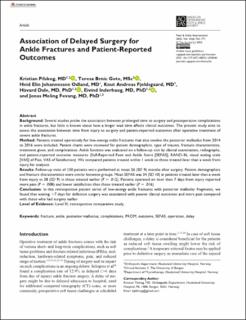| dc.contributor.author | Pilskog, Kristian | |
| dc.contributor.author | Gote, Teresa Brnic | |
| dc.contributor.author | Odland, Heid Elin Johannesen | |
| dc.contributor.author | Fjeldsgaard, Knut | |
| dc.contributor.author | Dale, Håvard | |
| dc.contributor.author | Inderhaug, Eivind | |
| dc.contributor.author | Fevang, Jonas Meling | |
| dc.date.accessioned | 2022-09-09T13:01:04Z | |
| dc.date.available | 2022-09-09T13:01:04Z | |
| dc.date.created | 2022-05-25T09:21:43Z | |
| dc.date.issued | 2022 | |
| dc.identifier.issn | 1071-1007 | |
| dc.identifier.uri | https://hdl.handle.net/11250/3016929 | |
| dc.description.abstract | Background: Several studies probe the association between prolonged time to surgery and postoperative complications in ankle fractures, but little is known about how a longer wait time affects clinical outcomes. The present study aims to assess the association between time from injury to surgery and patient-reported outcomes after operative treatment of severe ankle fractures.
Method: Patients treated operatively for low-energy ankle fractures that also involve the posterior malleolus from 2014 to 2016 were included. Patient charts were reviewed for patient demographics, type of trauma, fracture characteristics, treatment given, and complications. Ankle function was evaluated on a follow-up visit by clinical examination, radiographs, and patient-reported outcome measures (Self-Reported Foot and Ankle Score [SEFAS], RAND-36, visual analog scale [VAS] of Pain, VAS of Satisfaction). We compared patients treated within 1 week to those treated later than a week from injury for analyses.
Results: Follow-up visits of 130 patients were performed at mean 26 (SD 9) months after surgery. Patient demographics and fracture characteristics were similar between groups. Mean SEFAS was 34 (SD 10) in patients treated later than a week from injury vs 38 (SD 9) in those treated earlier (P = .012). Patients operated on later than 7 days from injury reported more pain (P = .008) and lower satisfaction than those treated earlier (P = .016).
Conclusion: In this retrospective patient series of low-energy ankle fractures with posterior malleolar fragments, we found that waiting >7 days for definitive surgery was associated with poorer clinical outcomes and more pain compared with those who had surgery earlier. | en_US |
| dc.language.iso | eng | en_US |
| dc.publisher | SAGE | en_US |
| dc.rights | Navngivelse 4.0 Internasjonal | * |
| dc.rights.uri | http://creativecommons.org/licenses/by/4.0/deed.no | * |
| dc.title | Association of Delayed Surgery for Ankle Fractures and Patient-Reported Outcomes | en_US |
| dc.type | Journal article | en_US |
| dc.type | Peer reviewed | en_US |
| dc.description.version | publishedVersion | en_US |
| dc.rights.holder | Copyright 2022 the authors | en_US |
| cristin.ispublished | true | |
| cristin.fulltext | original | |
| cristin.qualitycode | 2 | |
| dc.identifier.doi | 10.1177/10711007211070540 | |
| dc.identifier.cristin | 2027192 | |
| dc.source.journal | Foot & ankle international | en_US |
| dc.source.pagenumber | 762-771 | en_US |
| dc.identifier.citation | Foot & Ankle International. 2022, 43 (6), 762-771. | en_US |
| dc.source.volume | 43 | en_US |
| dc.source.issue | 6 | en_US |

